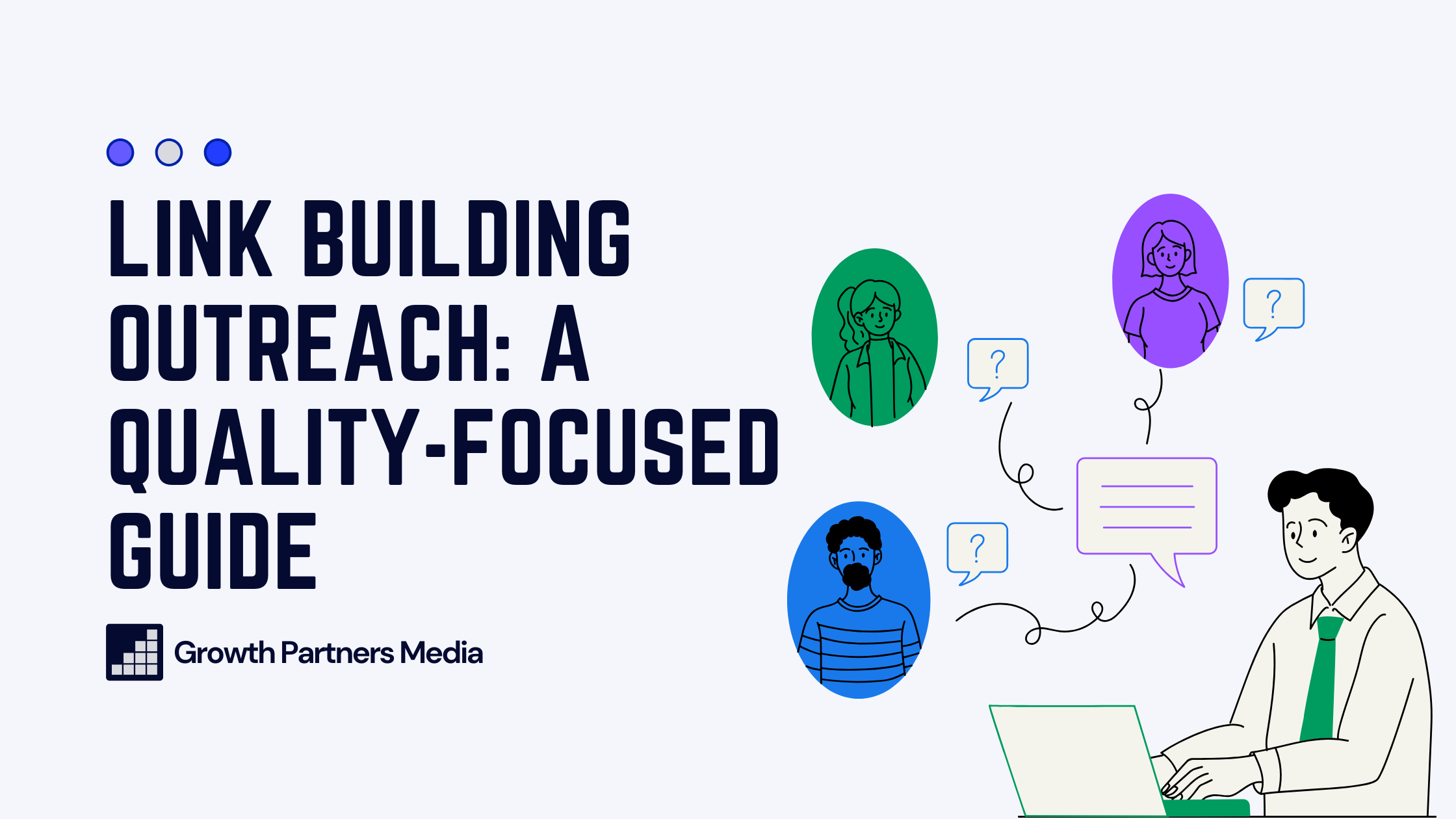Most people suck at link building outreach.
There, I said it.
You’ve seen it firsthand — your inbox flooded with generic, desperate pleas for backlinks. Messages that read like they were written by an intern who’s never built a link in their life.
“Dear Sir/Madam, I came across your wonderful website and would love to collaborate.”
❌ Delete.
This is exactly why link outreach has a terrible reputation. The internet is drowning in low-effort, mass-blasted emails that no one in their right mind would respond to.
And guess what?
That’s why link building outreach doesn’t work for 99% of people—they treat it like a numbers game instead of a people-first strategy.
But here’s the good news:
If you focus on quality, relationships, and real value, you’ll stand out like a flare in the night sky.
Because while everyone else is spamming inboxes, you’ll be building links that actually move the needle.
This is exactly what we’ve been doing for clients at Growth Partners Media for the last 5 years through our link outreach services.
We don’t waste time on mass outreach. Instead, we leverage exclusive partnerships, proven outreach strategies, and human-first connections to deliver high-quality, high-impact backlinks.
In this guide, we’re pulling back the curtain on:
- Why most link building outreach fails (and how to avoid the same fate).
- The difference between spammy outreach and strategic, quality-driven outreach.
- Our tested approach for securing links that actually matter.
If you’re tired of playing the link building lottery and ready to start winning the smart way, let’s get into it.
What Is Link Building Outreach and Why It Matters
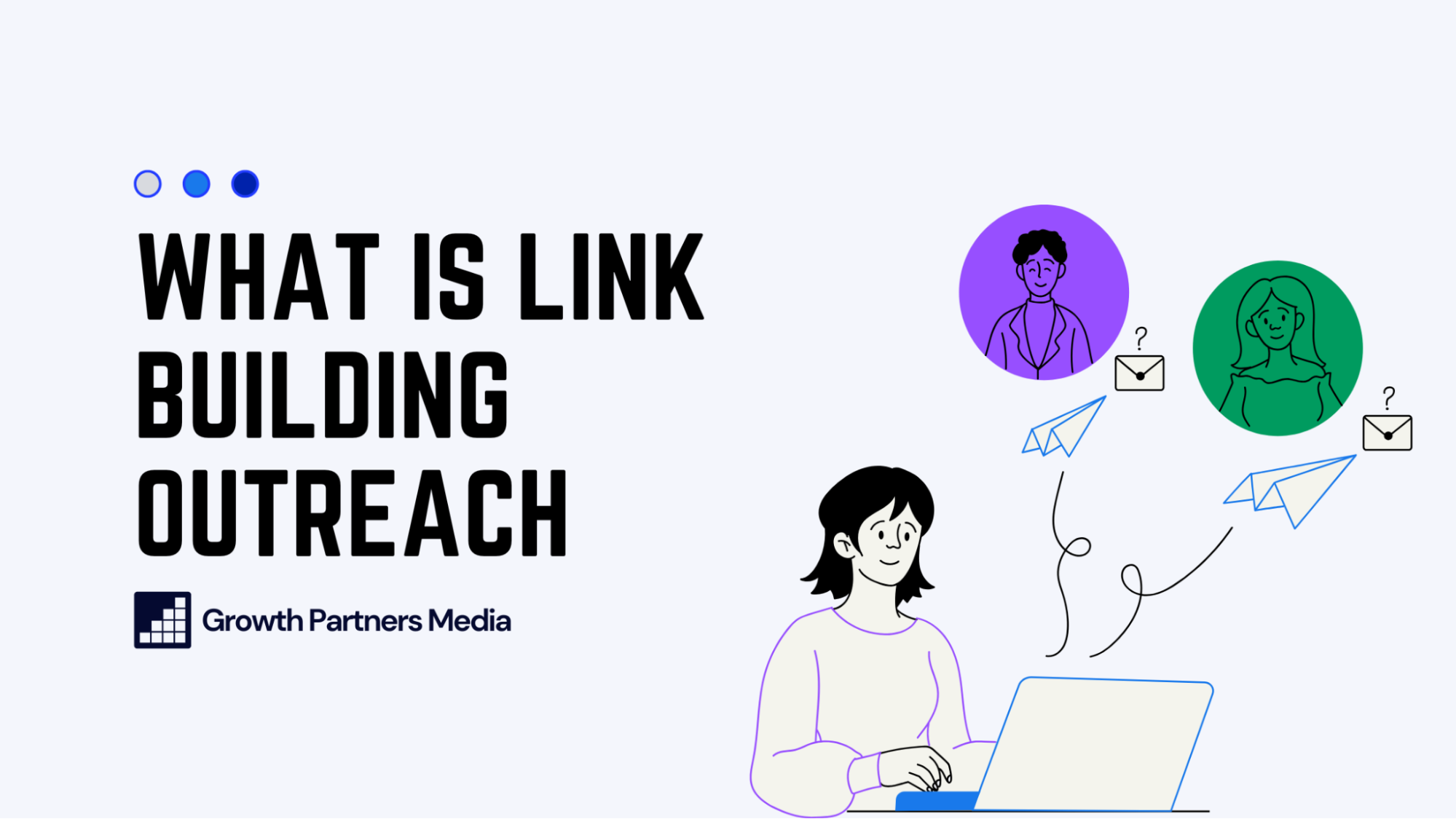
Link building outreach campaign is exactly what it sounds like—the process of reaching out to relevant, authoritative websites to secure do-follow backlinks that strengthen your SEO. But if you think that means blasting a hundred templated emails and praying for a response, think again.
At its core, outreach link building is about building relationships, offering value, and earning manual links that actually move the needle.
The goal?
To land backlinks from sites that:
✅ Have a strong domain rating.
✅ Are contextually relevant to your niche.
✅ Have the potential to send referral traffic.
When done right, this link building process positions your brand as a trusted authority, fuels organic growth, and helps your site rank higher in search engines.
But not all backlinks are created equal…
Why high-quality backlinks still matter in 2025
If you’ve been keeping up with SEO, you’ve probably heard it a hundred times:
“Links don’t matter as much anymore.”
Let’s be clear — that’s complete nonsense.
Google’s algorithms have evolved, yes. AI-driven search experiences are changing the way users interact with information, absolutely. But the fundamental principles of trust, authority, and relevance still hold weight, and backlinks remain one of the strongest signals of a site’s credibility.
Here’s why:
1️⃣ Backlinks are a vote of confidence. When an authoritative site links to yours, it’s telling Google, “Hey, these guys know what they’re talking about.” That credibility boost is irreplaceable.
2️⃣ They drive traffic. Unlike social media posts that vanish into the abyss, a well-placed backlink can send qualified visitors for years, not just for a fleeting moment.
3️⃣ Emerging GEO (Generative Engine Optimization) makes links even more important. As AI-driven search becomes the norm, it’s leaning heavily on authoritative sources to generate reliable responses. Websites with strong backlink profiles will continue to dominate as search engines and LLM’s prioritize credibility in their AI-curated answers.
This means low-quality, spammy links won’t cut it anymore — but high-quality and safe backlinks from reputable sources?
They’re more valuable than ever.
So, how do you secure the links that actually matter?
That’s where our quality-first, relationship-driven approach to outreach comes in.
Key Benefits of a Backlink Outreach Campaign

Backlinks aren’t just some arbitrary SEO checkboxes—they are one of the strongest signals of content value and trustworthiness in the eyes of search engines.
When a reputable site links to yours, it’s like getting a public endorsement.
Google takes notice. Readers take notice. And if you’ve done it right?
Jeff Goldblum celebrates for you:

Well, maybe that’s a stretch!
But that single backlink can lead to higher rankings, more organic traffic, and ultimately—more leads and sales.
Let’s break it down:
✅ Higher Rankings – Search engines prioritize pages with strong, relevant backlinks because they act as a trust signal. The more quality links you earn, the better your chances of securing those top positions.
✅ More Traffic – Not all traffic comes from Google. A well-placed backlink on an authority site sends highly qualified visitors your way—people already interested in what you offer.
✅ Leads & Sales – A backlink from the right website isn’t just a vanity metric. It’s a direct pipeline to potential customers. Unlike PPC ads that stop working the moment you stop paying, a great backlink can drive conversions for years.
Here’s a screenshot from Breezit, a wedding and event vendor SaaS client we worked with in 2024. Can you see how the increase in backlinks (referring domains) correlates heavily with the growth in organic traffic?
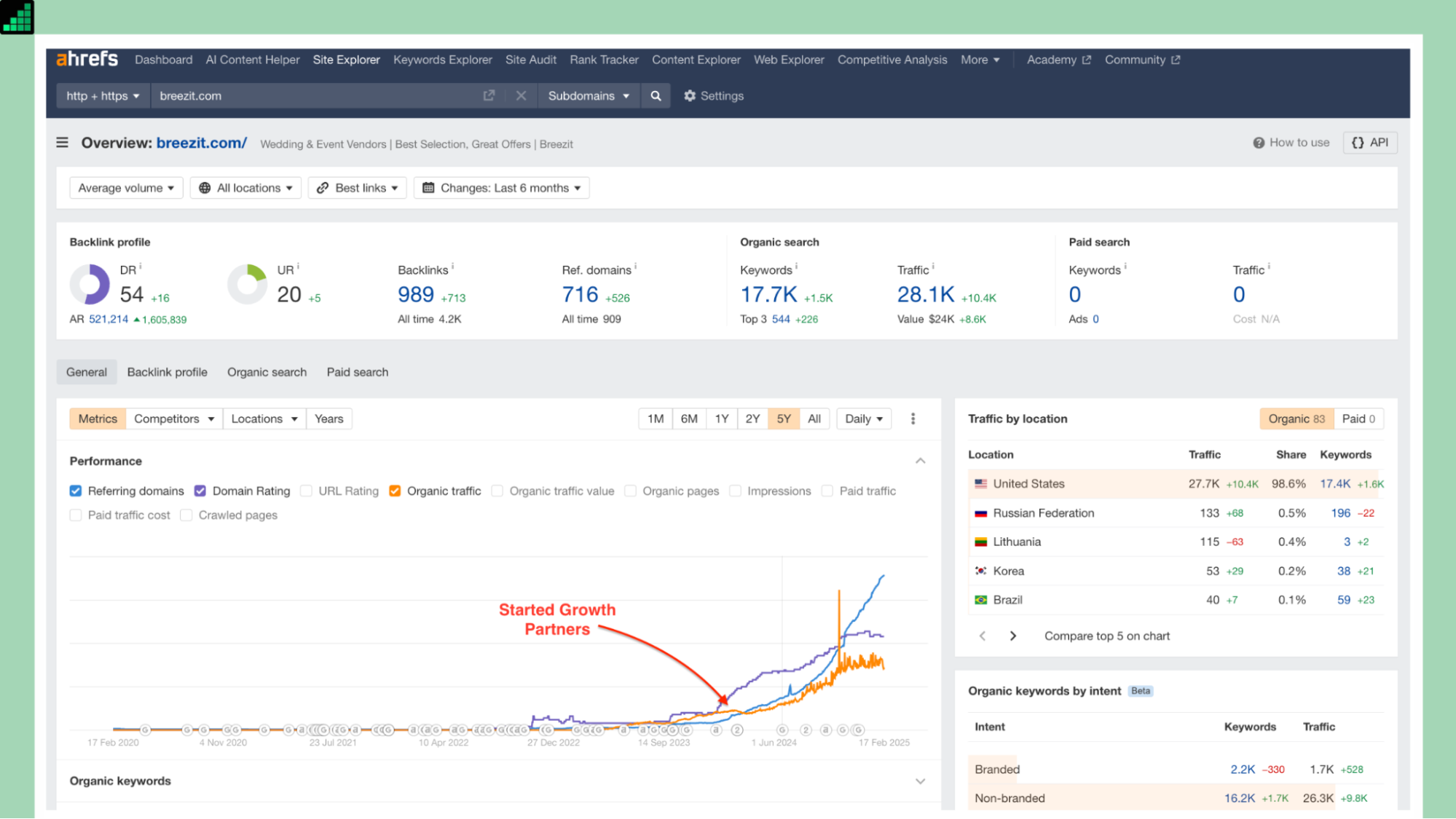
Recap: More credibility = Higher rankings = More traffic
High-quality backlink outreach isn’t just about SEO rankings—it’s about building long-term brand authority and trust that translates into real business growth.
Building industry relationships
Here’s where most SEOs get it wrong:
They think link building outreach is just about grabbing a backlink and moving on. That’s amateur hour.
Do you want to build links or dominate SEO?
SEO domination comes when you build relationships with industry-leading websites, editors, and content managers who see you as a trusted voice in the space. When done right, these relationships can unlock opportunities your competition can only dream about.
Here’s what this looks like in action:
🚀 Landing dream-tier links on untouchable websites. Through our quality-focused approach, we’ve secured client backlinks on OpenCart, Timify, and Mention—the kind of links that competitors cannot reverse-engineer.
🎯 Opening doors to more opportunities. A single great relationship can lead to multiple backlinks, guest post opportunities, and collaborations that keep your brand visible in all the right places.
🔥 Creating an SEO moat. Unlike PBNs, spammy guest posts, or shady link farms, the backlinks we land aren’t just powerful — they’re uncopyable (if that’s even a word). By consistently building connections with top-tier industry sites, you create a competitive advantage that no AI tool or backlink scraper can replicate.
Speaking about AI, it’s evident that it’s impacting the world of Search Engine Optimization (SEO). There’s something that self-proclaimed gurus don’t mention. Generative AI platforms (like ChatGPT) still have only a fraction of Google’s users.
The idea that everyone is using ChatGPT comes from the False consensus effect. Most of you reading this live in a marketing bubble influenced by the mentioned effect.
Everyone from your working circle and LinkedIn connections is constantly talking about AI.
This tricks our minds into believing that the trend is spread across the globe when it is simply not the case.
Effective Link Outreach Techniques
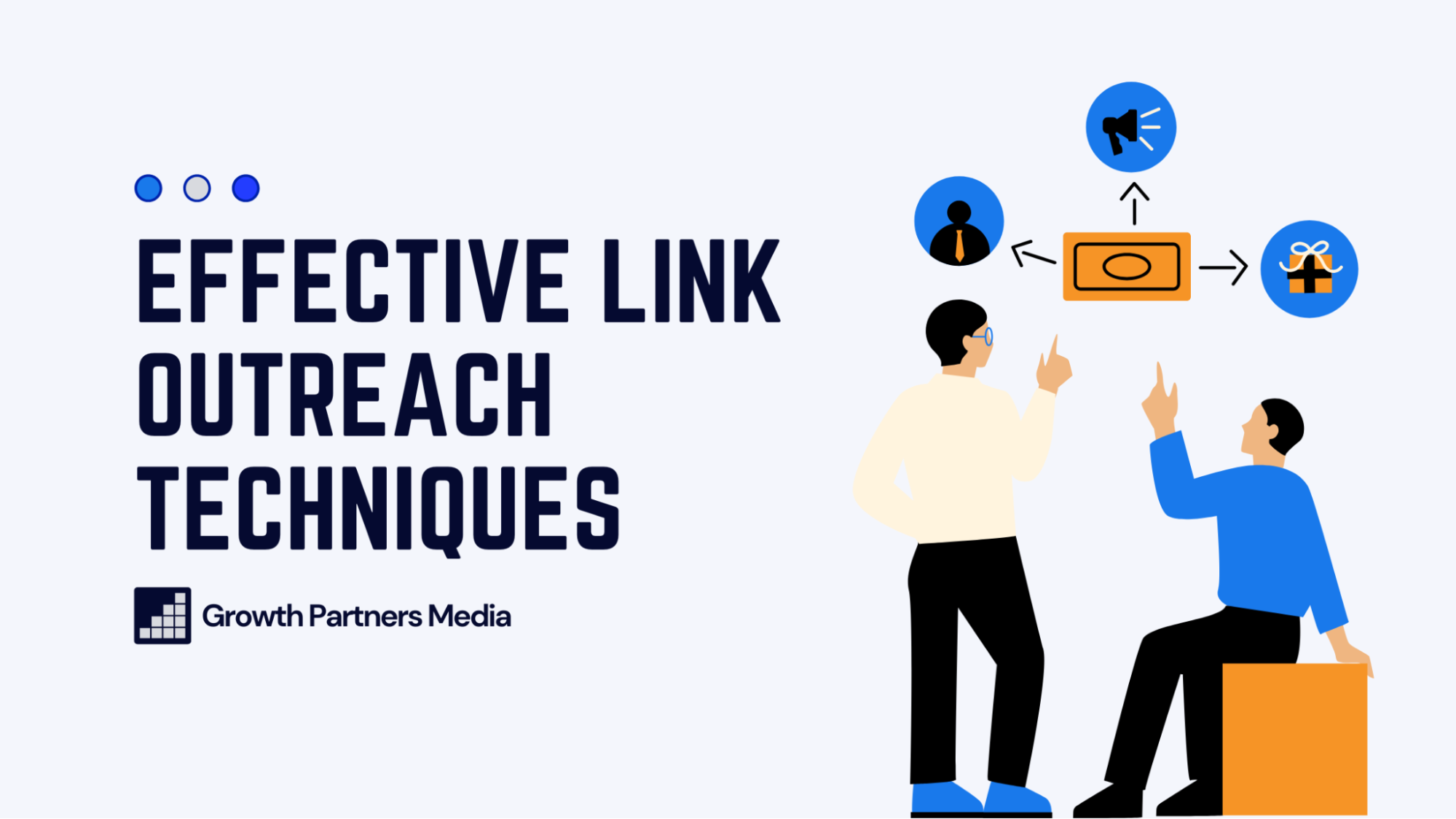
There are three main ways to secure backlinks through outreach.
While each method comes with different strategies and execution styles, they all boil down to one thing:
Earning high-quality, relevant links through direct engagement.
Let’s break them down.
Outreach links (niche edits/link inserts)
Getting niche edits is one of the fastest, most efficient ways to land powerful backlinks.
Instead of waiting for someone to discover your content and link to it (which let’s be honest, rarely happens on its own), you reach out to site contacts and request a link placement within an existing, relevant article.
Why does this work so well?
✅ It’s natural – You’re not forcing an unrelated link into a new post but enhancing an article with a valuable, relevant resource.
✅ It’s efficient – No need to write new content. You’re leveraging already-ranking pages to add your link where it makes sense.
✅ It’s fast – A well-crafted pitch can get you a placement in days, not months — a much quicker turnaround than waiting for guest posts or organic mentions.
Done right, outreach link building is one of the most powerful techniques in your SEO arsenal. But like anything, context is king—you can’t just insert a link and expect magic. The article must be relevant, the link must add value, and the site must be worth getting a backlink from in the first place.
You can buy niche edits through our dedicated service.
Guest posting
Guest posting is an OG technique of link building — and while some claim it’s overdone, the reality is this:
It still works phenomenally well when executed strategically.
At its core, guest posting is simple:
- You write high-quality content for another website in your niche.
- You provide genuine value to their audience.
- In return, you get a backlink (or two) to your own site.
But not all guest posts are created equal.
Too many SEOs chase low-quality, spam-riddled blogs that accept anything and everything. That’s not real guest posting; that’s link farming in disguise.
True high-quality guest posting means:
✅ Publishing on respected, authoritative sites that people actually read.
✅ Writing content that is as good—if not better—than what you publish on your own site.
✅ Earning the link, not forcing it into an irrelevant, low-effort piece.
A high-quality guest post builds brand authority, drives referral traffic, and lands you backlinks that actually move the needle.
Digital PR
If outreach links and guest posts are about playing chess, digital PR is the checkmate move.
This strategy isn’t just about building links — it’s about getting your brand in front of top-tier media, industry publications, and journalists who can amplify your message.
Digital PR involves:
📢 Creating newsworthy content – Think data-driven studies, unique insights, or expert takes on trending topics.
🎯 Targeting journalists and industry reporters – These are the people who can put your brand on the map with high-value, hard-to-get links.
🚀 Building authority beyond SEO – Digital PR links don’t just boost rankings; they establish your business as an industry leader.
And the best part?
A single successful digital PR campaign can land you on sites your competition could only dream of — TechCrunch, Business Insider, The Guardian. The kind of authority links that supercharge your SEO outreach efforts.
Each of these three techniques has its strengths. The key is knowing which ones to use and how to combine strategies for the optimal approach.
The challenge with Digital PR is it’s expensive and difficult to pull off. You may spend $10K on a campaign with no results because your angle failed. Even great Digital PR agencies have campaigns that flop.
Outreach links, guest posting and digital PR are the 3 most effective forms of link-building outreach. Doing it right is not easy, that’s why many companies choose to outsource their backlink building efforts.
How We Create Awesome Link Building Outreach Campaigns
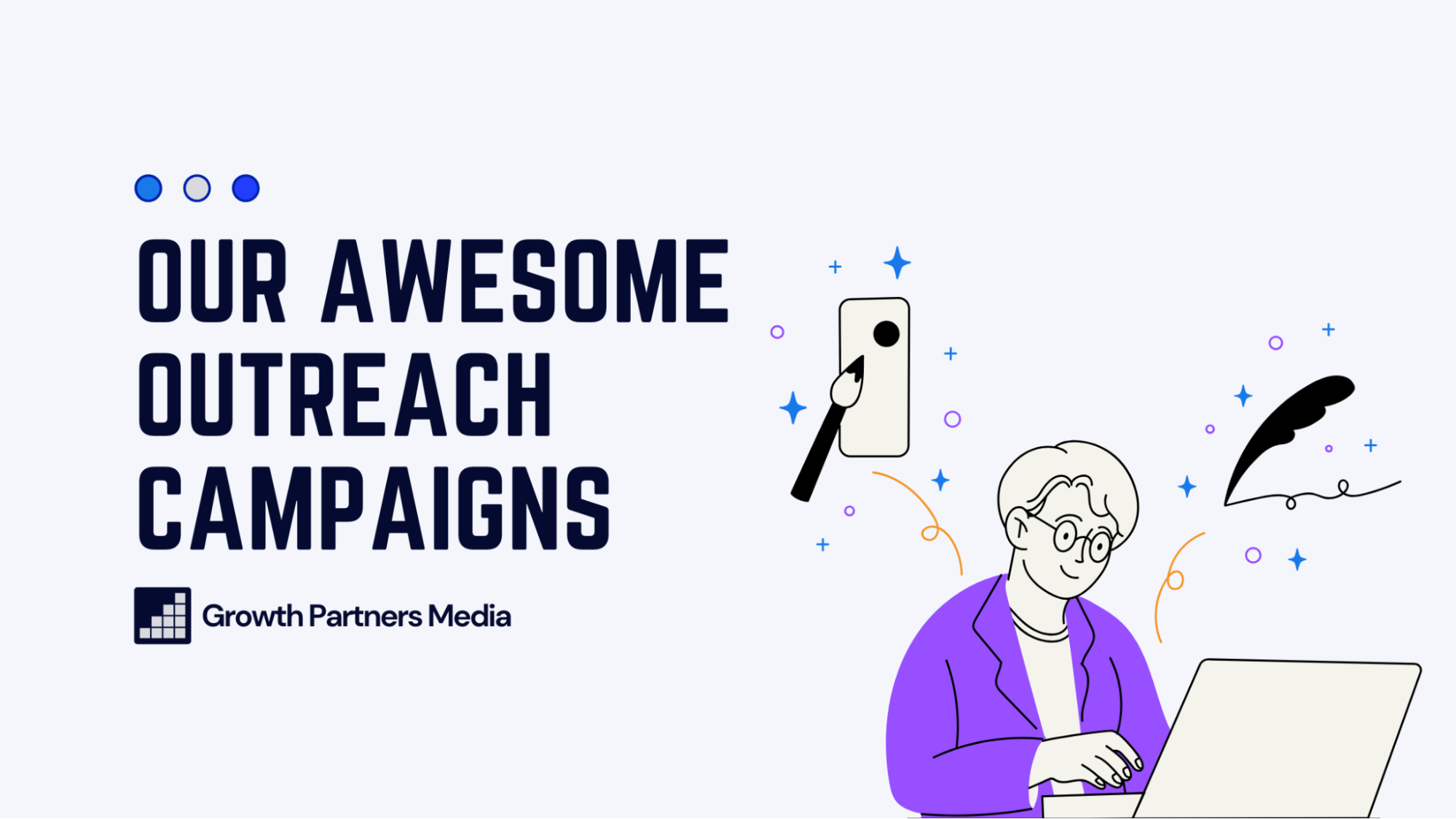
Now let’s talk about how to run a campaign that delivers.
Link building outreach isn’t linear.
There’s no one-size-fits-all blueprint, and blindly following cookie-cutter templates won’t get you anywhere.
So what works?
A well-planned link building strategy that blends email copywriting expertise with focused execution and an ability to pivot as needed.
At Growth Partners Media, we’ve spent years refining our process — not just to get any links, but to get the right authority backlinks.
Authority backlinks are very different from ordinary links. The difference between one authority link can be thousands of times more than a standard backlink.
Yes, THOUSANDS!
You can measure this purely through DR to give you a faint idea. But we have a 15-point qualification crtieria we use to audit websites before approaching them for a link.
We’ve done a lot of saas link building and worked in other industries too, from crypto metaverse gaming to aerospace components and e-com furniture.
Below, we’ll walk you through the core steps we take to craft a successful outreach campaign.
Step 1: Email infrastructure – the foundation of deliverability

Email outreach has completely changed in the past few years. If you’re still blasting messages from a generic Gmail account, you’re in big trouble!
Today, email providers prioritize sender reputation, domain authenticity, and engagement.
Without a rock-solid email infrastructure, your campaigns won’t even make it past the spam filters.
Here’s what we set up before sending a single email:
📌 SPF (Sender Policy Framework) – Validates that emails from your domain are legit. If you don’t configure this, good luck getting into inboxes.
📌 DKIM (DomainKeys Identified Mail) – Ensures your email hasn’t been tampered with. Think of it like sealing a letter with an official stamp.
📌 DMARC (Domain-based Message Authentication) – Stops scammers from spoofing your domain and tanking your sender reputation.
📌 Email Warmups – Gradually ramping up email volume to build trust. If you think you can start sending 500 cold emails a day with a fresh domain, you’re going to end up in email purgatory (aka the spam folder).
📌 Bounce Management – Keeping your list clean by filtering out invalid or deactivated email addresses. High bounce rates = bad news for deliverability.
This is just the bare minimum — we’ve got an entire system dedicated to monitoring and optimizing email infrastructure so that our messages land where they need to.
Step 2: Create link-worthy content – the bait that attracts high-quality links
You can’t just ask for links—you have to earn them.
If you’re pitching weak, outdated, or generic content, you’ll struggle to land links to it.
At GPM, we create and refine content with link-worthiness in mind. This means:
✅ Data-driven insights – Original studies, surveys, or industry reports get natural backlinks.
✅ Unique perspectives – No one wants to link to the same regurgitated SEO fluff.
✅ Broad appeal with niche relevance – Content should work across industries while staying specific enough to provide deep value.
We also optimize our content’s structure and readability — because no matter how good your information is, if it looks like a brick wall of text, nobody will engage with it.
Step 3: Research and targeting – finding the right link opportunities

Most people take a spray-and-pray approach to outreach. That’s why they struggle to get any traction.
Instead, we start by identifying high-authority websites in relevant industries that meet our strict qualification criteria (more on that next).
We also analyze where competitors are getting their backlinks. If a site linked to them, they might be open to linking to us — provided we give them a better reason to.
There are various angles you can employ here that we won’t be sharing. We reserve our best ones for client work and besides – if you’re copying strategies from blog posts you’re doing it wrong.
Every amatuer marketer is doing that and getting no results.
You need to put your own unique twist on things and use that beautiful brain of yours!
At the end of our process, we end up with a highly targeted list of websites and the right contacts to email.
For a long time, we were sending emails to the wrong people and while we still landed guest posts and niche edit links, our response rates were pretty low.
Shifting our approach to finding people who we know will be receptive to our outreach has made a gargantuan difference.
Step 4: Qualifying websites – separating the gold from the garbage
Not all backlinks are worth chasing.
There are thousands of spammy, low-quality websites that will take your money for a link. But those aren’t the links that move the needle.
I can’t underline this one enough:
Avoid spammy websites.
By building links on low-quality websites you’re likely to lose in the long run. Sure, some temporary boost might happen, but it won’t support the steady growth of your site you’re after.
At GPM, we have strict filtering criteria that ensure we only reach out to legitimate, high-value sites.
🚀 Strong Domain Authority – But not just DA/DR. We look at actual ranking power.
🚀 Real Organic Traffic – If a site gets no real visitors, the backlink is worthless.
🚀 Relevance to Our Niche – A SaaS company doesn’t need a backlink from a random BBQ blog.
🚀 Clean Link Profile – If a site is filled with spammy outbound links, we stay far away.
These are just 4 key points from our 15-point qualification checklist.
This level of qualification is what separates the great from the good – and bad when it comes to link building campaigns.
Step 5: Gathering contact data – reaching the right people
We go straight to the decision-makers—SEO managers, content editors, marketing leads. The people who actually have the power to say yes.
Our favorite link building outreach tool is Apollo, but we also use LinkedIn and private databases to find direct emails. If we can’t find the right contact, we move on. No time wasted.
Step 6: Create standout sequences – The art of the perfect pitch

Most outreach emails are boring at best.
At worst, they get a “fuck off” reply.
Why?
Because they’re all take, take, take. Look, why the hell should someone link to you?
You need to give them a compelling reason.
Whether you do that through humour, personalisation or pure value. There’s many ways to skin a cat as they say.
Every email we send is:
🔥 Personalized – No “Dear Sir/Madam” nonsense. We reference specific things about the recipient but not in a cheesy, disingenuous way that we’ve all seen a thousand times before.
🔥 Concise and value-driven – No one has time to read an essay. We get straight to the point—what’s in it for them? Value, value, value.
🔥 Engaging and human – We win them over with some cheeky humour, a well-placed GIF or a relatable mini story. Save the robotic tone for the machines.
This is why we get replies like this:
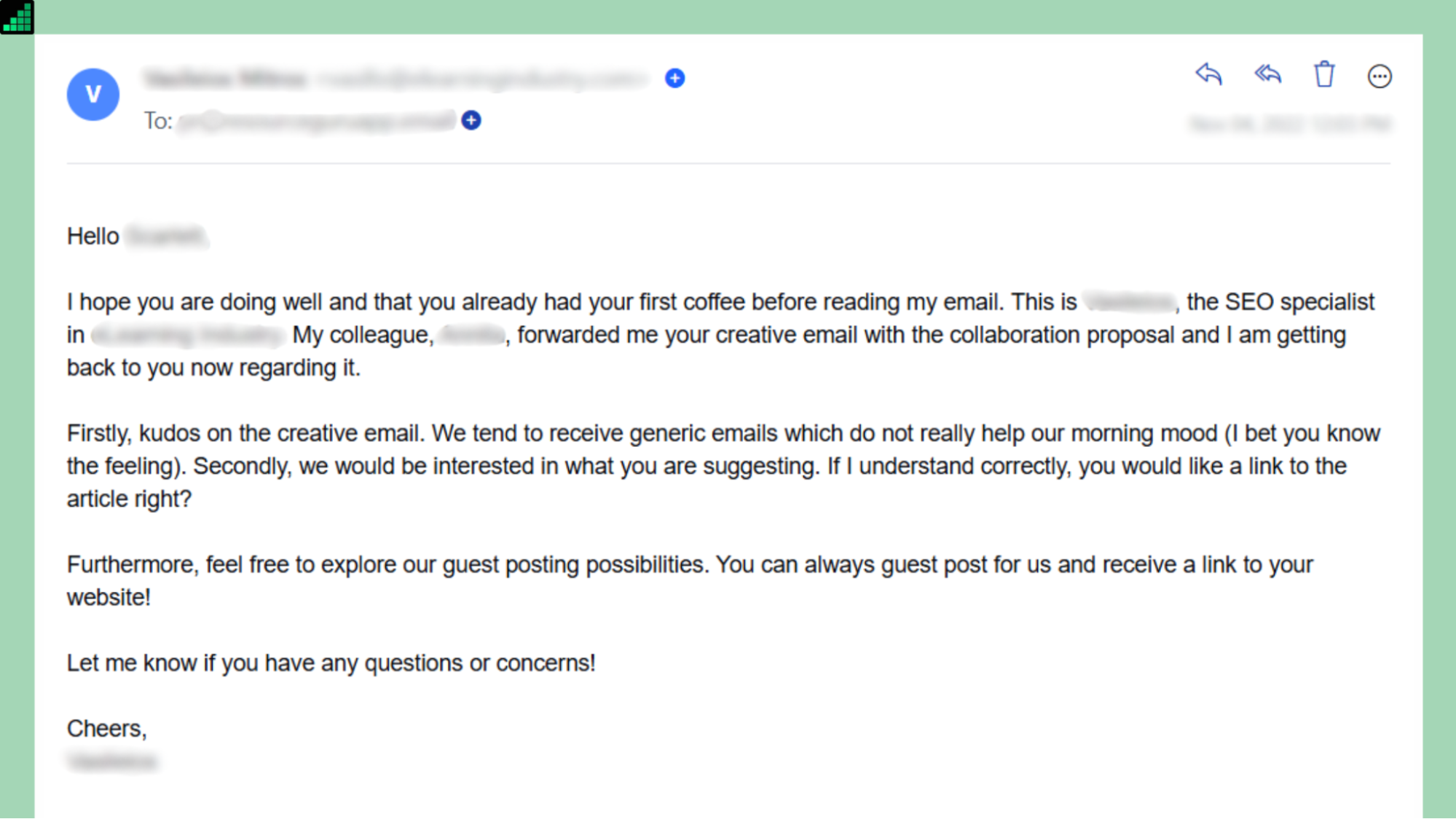
We don’t stop at one email. Our sequences are multi-touch — designed to keep prospects engaged without being annoying.
Step 7: Kicking off campaigns – timing & execution
Once everything is in place, we launch in controlled phases — never all at once.
Blasting emails out in one go is amateur hour. It wrecks deliverability, floods inboxes at the wrong time and removes any chance to optimize based on real-time feedback.
Instead, we test, monitor, and refine as we go.
The first batch of emails is our test round. We track open rates, response rates, and engagement levels to see what’s working and what needs adjusting.
If a subject line flops, we tweak it.
If response rates are low, we refine the messaging. This is how we turn data into results instead of blindly hoping for the best.
Before you progress with your outreach campaign I want you to obsess over the subject line.
The subject line is the crucial factor. It makes the difference between the 10% and 45% outreach email opening rates.
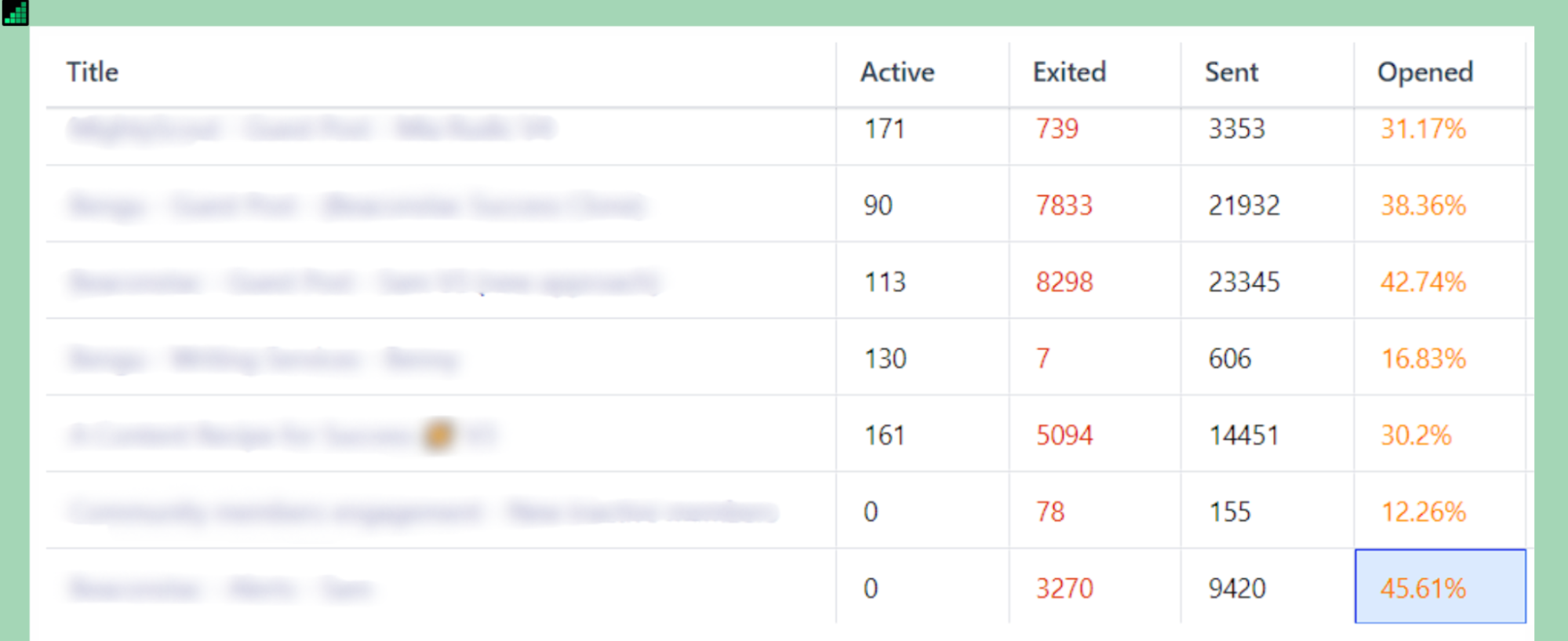
Timing is everything.
We don’t just fire off emails at random hours — we schedule them based on the recipient’s timezone. The goal is to land in their inbox when they’re most likely to open and engage, not buried under a pile of unread messages from the night before.
Follow-ups are just as precise.
Too soon, and you’re annoying. Too late, and you’re forgotten.
The key is to hit the right balance, ensuring emails land when they should, not when it’s convenient for us to send them out.
Step 8: Negotiate replies – the final push
Getting a reply doesn’t mean getting a link.
Most responses fall into three categories: interested, hesitant, or rejection.
We don’t waste time on dead leads, but if someone’s on the fence, we pivot and try to find a win-win.
Some need more value—so we offer deeper collaboration. Others push for payment—we vet if it’s worth it.
Here’s a real example straight from our inbox:
The person replied after several follow-ups. They were happy to link to our content as long as they got something in return.
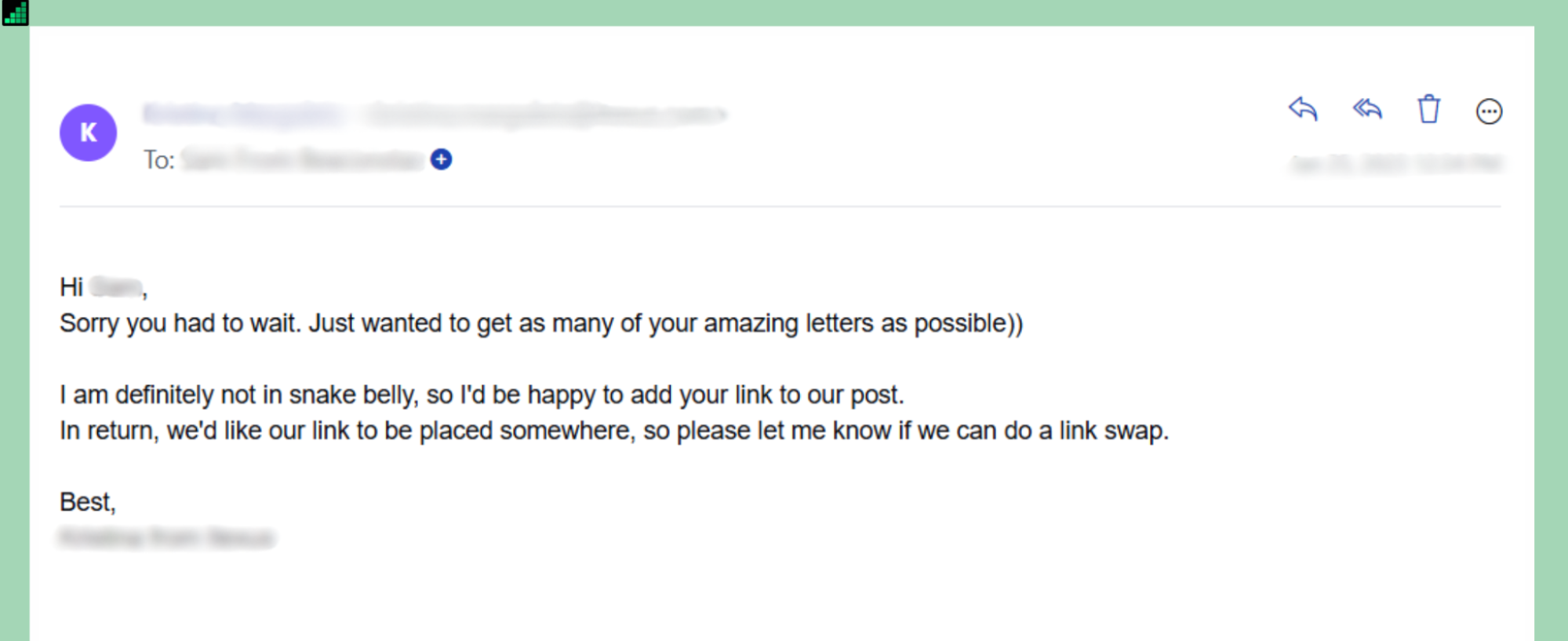
We offered a link insert on a website with a DR slightly higher than their site. A few hours later, our link was live and they submitted a request for the site we offered!
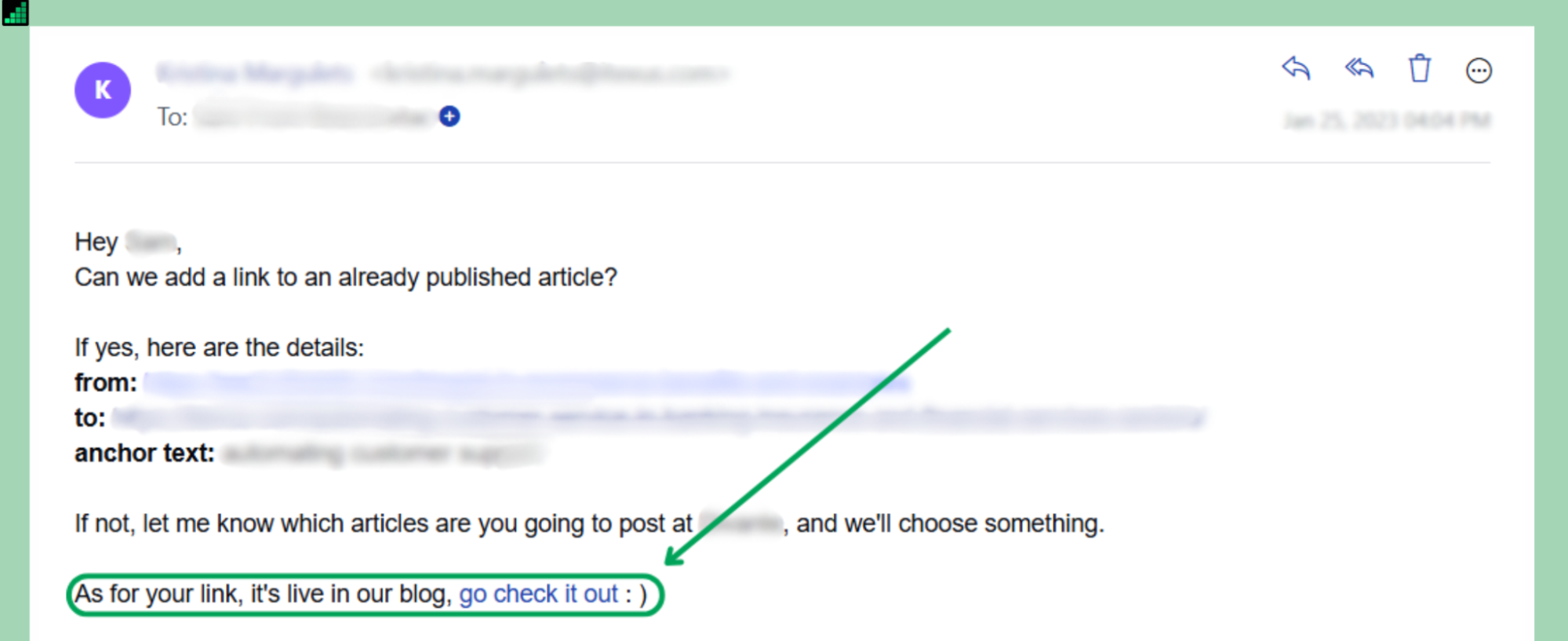
Every response is an opportunity.
This isn’t just outreach — it’s negotiation. And we make sure it ends with a link that’s worth the effort.
Step 9: Reviewing metrics and split-testing – optimizing for maximum ROI
Outreach isn’t just about sending emails and hoping for the best. It’s a constant cycle of testing, measuring, and refining—because what worked last month might not work today.
The difference between a mediocre campaign and a high-performing one?
Knowing which numbers actually matter and how to act on them.
📊 Open rates
If emails aren’t being opened, the problem starts at the subject line. We A/B test multiple variations to see what resonates, adjusting based on performance. Sometimes, even a small tweak—like adding a first name or making the subject more curiosity-driven—can mean the difference between getting ignored and getting noticed.
📊 Response rates
An open doesn’t mean anything if no one replies. If response rates are low, we analyze messaging, personalization, and timing.
- Are we reaching out to the right people?
- Does the email feel human, or does it read like another templated pitch?
- Are we hitting inboxes at the right time?
By testing different angles—like shifting from a cold pitch to a value-first approach—we refine our messaging to boost engagement.
📊 Deliverability
Even the best emails won’t get results if they’re landing in spam. We monitor:
- Bounce rates – A high bounce rate means bad data or invalid contacts.
- Spam complaints – If people are marking our emails as spam, something’s off in our targeting or messaging.
- Inbox placement – If we’re getting buried in “Promotions” instead of landing in primary inboxes, we adjust sending infrastructure (SPF, DKIM, DMARC, and warming strategies).
🔄 Continuous optimization
We don’t guess. Every adjustment is based on real numbers, and we split-test everything.
- If a subject line improves open rates by 15%, we scale it.
- If a call-to-action (CTA) boosts replies by 20%, we refine it further.
- If an email template underperforms, we kill it fast and try something better.
The end goal? Systematically improving every campaign so that each one performs better than the last.
Successful outreach isn’t just about sending more emails—it’s about sending the right emails to the right people at the right time.
And the only way to do that?
Track. Test. Improve. Repeat.
Conclusion: Mastering Link Building Outreach the Right Way
160 billion spam emails are sent every day.
Most of them? Ignored. Deleted. Forgotten.
That’s why real outreach isn’t about sending more emails—it’s about sending the right emails to the right people, in the right way.
The key to success?
Personalized, people-first outreach.
Forget blasting generic templates to 500 websites and hoping for the best. Relationships, relevance, and trust are what move the needle.
Strong results don’t happen by accident.
Every step — email infrastructure, contact research, qualification, and follow-ups—matters. A single weak link can derail your entire strategy.
That’s why we don’t guess.
At Growth Partners Media, we go beyond traditional outreach. Our exclusive network, proven systems, and relationship-driven approach deliver high-authority backlinks that actually drive rankings, traffic, and brand trust.
If you’re ready to skip the trial and error and start building links that move the needle, schedule a call to see if you’re a fit.
- How to Outsource Backlink Building Without Stress [2025] - October 7, 2025
- Top 3 SEO Outreach Services That Actually Work [2025] - October 7, 2025
- 9 White-Hat Link Building Techniques For AI & Google (2025) - September 23, 2025

